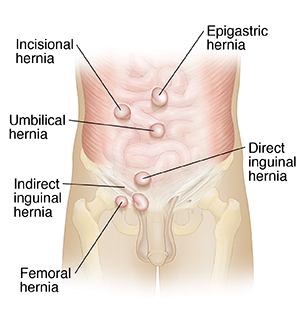What Is a Hernia?
A hernia is when an organ or tissue pushes through a weak spot in the muscle or tissue that normally holds it in, such as the belly (abdominal) wall. This weak spot may be there at birth. Or it may be caused by abdominal strain over time. If not treated, a hernia can get worse with time and physical stress.
When a bulge forms
When there is a weak spot in the abdominal wall, an organ or tissue can push outward. This often causes a bulge that you can see under your skin. The bulge may get bigger when you stand up. It may go away when you lie down. You may also feel some pressure or mild pain when lifting, moving, coughing, urinating, or having a bowel movement.
Types of hernias

The type of hernia you have depends on where it is. Most hernias form in the groin at or near the internal ring. This is the entrance to a canal between the abdomen and groin. Hernias can also occur in the abdomen, thigh, or genitals.
-
Incisional hernia. This occurs at the site of a previous surgical cut (incision).
-
Umbilical hernia. This occurs at the belly button (navel). It occurs when the muscle around the belly button does not close completely after birth.
-
Indirect inguinal hernia. This occurs in the groin at the internal ring. It often happens in premature births, before the inguinal canal becomes closed.
-
Direct inguinal hernia. This occurs in the groin near the internal ring. It usually results from the weakening of the belly muscles over time. This is more common in adult males.
-
Femoral hernia. This occurs just below the groin, in the upper thigh. It is more common in women than in men.
-
Epigastric hernia. This occurs in the upper abdomen at the midline.
-
Hiatal hernia. This occurs when part of the upper stomach comes through an opening in your diaphragm, or chest wall.
-
Congenital diaphragmatic hernia. It is congenital (a baby is born with it). This happens when the diaphragm doesn’t form right in infants.
Other types of hernias can occur. But they are rare.
Diagnosis
In most cases, your health care provider can diagnose a hernia with a physical exam.
In some cases, it might not be clear why you have swelling in the belly wall. You may need an imaging test such as an ultrasound or CT scan. This can help with the diagnosis.
If there is a blockage in the bowel, an X-ray of the abdomen may be done.
Surgery
In children, an umbilical hernia can often heal on its own. If it doesn't heal on its own by the time a child is age 5 years, it will likely need to be repaired.
In adults, a hernia will not heal on its own. Surgery is needed to repair the weak spot in the belly wall. Most hernias are closed with stitches and sometimes with mesh patches to plug the hole. If not treated, a hernia can get larger. It can cause serious health problems. Some hernias can be watched and repaired if they grow bigger or start to cause symptoms.
Most hernias are fixed with laparoscopic surgery. This type of surgery is done through several very small cuts. Some types of hernias may need surgery where a larger cut is made in the belly. In some cases, you can go home on the same day as your surgery.
When to contact your provider
Contact or see your health care provider right away if the swelling around your hernia becomes larger, firmer, or more painful. It may be a sign that your intestines are stuck in the belly wall and their blood supply is in trouble. This is an emergency. The hernia must be repaired right away to prevent severe problems.